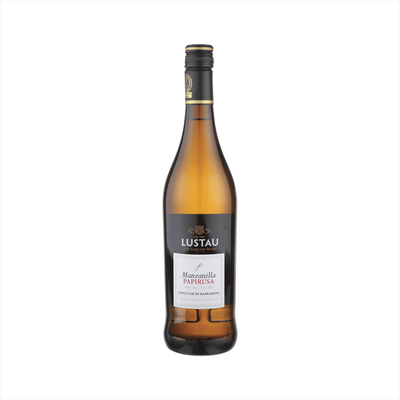Manzanilla Sherry
What is Manzanilla Sherry?
Manzanilla is a distinctive type of Sherry that can only be produced in the coastal town of Sanlúcar de Barrameda in Spain's Andalusia region. This bone-dry fortified wine develops under a thick layer of flor yeast, which gives it a characteristic briny, almost oceanic quality that sets it apart from other sherries. The salty sea air and unique microclimate of Sanlúcar influence the flor's behavior, creating Manzanilla's signature light, crisp profile with hints of almonds and a distinctive saline finish.
Learn More About Manzanilla Sherry
What makes Manzanilla Sherry unique?
Manzanilla stands apart from other sherries through its exclusive production in the coastal town of Sanlúcar de Barrameda, where the Atlantic Ocean's salty breezes and humid conditions create a uniquely thick layer of flor yeast that completely covers the wine throughout aging. This maritime influence gives Manzanilla its distinctive briny, almost seaweed-like character that you won't find in Fino sherry from inland Jerez, even though both wines use identical production methods. The result is a bone-dry, pale sherry with an unmistakable oceanic freshness that makes it the perfect companion for seafood and tapas.
How is Manzanilla Sherry made?
Manzanilla Sherry starts with Palomino grapes that are fermented into a dry white wine, then fortified to around 15% alcohol before entering the traditional solera aging system. The magic happens when a layer of wild yeast called flor develops naturally on the surface of the wine in oak barrels, protecting it from oxidation while adding distinctive salty, briny flavors. This biological aging process takes place exclusively in the coastal town of Sanlúcar de Barrameda, where the humid sea air creates perfect conditions for the flor to thrive and give Manzanilla its characteristic fresh, tangy profile.
How do you drink Manzanilla Sherry?
Manzanilla sherry is traditionally served neat and well-chilled in a small copita glass, allowing its delicate, briny character to shine through without dilution. While purists prefer it straight, this crisp Spanish wine also works beautifully in light, aperitif-style cocktails like a Sherry Cobbler or mixed with dry vermouth for a sophisticated twist on a martini. Its bone-dry, sea-kissed profile makes it perfect for warm weather sipping and pairs naturally with tapas, oysters, or any occasion calling for an elegant pre-dinner drink.
How do I choose good Manzanilla Sherry?
Look for producers like Hidalgo-La Gitana, Barbadillo, or Delgado Zuleta—these houses have been perfecting their craft for generations and consistently deliver that distinctive briny, almond-kissed character that makes Manzanilla special. For cocktails, grab a younger, crisper bottling since the drink's other ingredients will complement rather than compete with the sherry's delicate salinity, while sipping neat calls for something with a bit more age and complexity. Check the bottling date if possible—Manzanilla loses its magic pretty quickly once opened, so fresher is always better.
Nutritional Information
Typical Calorie Range per Ounce: 28-35 calories
Typical Carbohydrate Range per Ounce: 1-3 grams
Typical Sugar Range per Ounce: 0.5-2 grams
Typically Gluten Free: Yes
While Manzanilla Sherry is generally considered gluten-free since it's made from grapes rather than gluten-containing grains, individuals with celiac disease or severe gluten sensitivities should always check detailed product information and consult with manufacturers to confirm gluten-free status, as production methods and potential cross-contamination can vary between producers.
Scrolled this far? Your reward? Manzanilla Sherry Trivia!
- Manzanilla Sherry can only be aged in the coastal town of Sanlúcar de Barrameda, where the Atlantic Ocean's salty air creates a unique microclimate that makes the protective flor yeast grow thicker and more robust than anywhere else in Jerez. Move the barrels just 15 miles inland, and legally, you can't call it Manzanilla anymore—the flor behaves completely differently without that ocean breeze.
- The name "Manzanilla" means "little apple" in Spanish, but it has nothing to do with apples. It actually comes from the chamomile flower (manzanilla is also Spanish for chamomile), because early tasters thought the wine's delicate, herbal qualities reminded them of chamomile tea. Some old-timers still describe detecting faint floral notes that echo this original comparison.
- Manzanilla ages under a living blanket of yeast called flor that literally breathes—consuming oxygen and alcohol while producing aldehydes that give the wine its distinctive nutty, briny character. This biological aging process means Manzanilla is technically alive in the bottle, and the flor continues working until the wine reaches about 15.5% alcohol, at which point it dies and sinks to the bottom.
- Unlike most wines that deteriorate once opened, Manzanilla actually improves with controlled oxidation. Spanish bars traditionally keep opened bottles for weeks, and many sommeliers believe Manzanilla tastes better after being open for 2-3 days. The wine's high acidity and unique aging process make it remarkably stable, which is why it pairs so brilliantly with salty, oceanic foods like anchovies and olives.
- The solera aging system used for Manzanilla means your glass contains wine from multiple decades—some bodegas have soleras dating back over 100 years. When you drink a "young" Manzanilla, you're actually tasting a blend where the average age might be 8-12 years, with some components being much older. It's like drinking liquid history, with each sip containing traces of wines that witnessed the Spanish Civil War.
Higher-proof spirits can be intense. Mix carefully, taste thoughtfully, and enjoy responsibly.
Gift message (optional)

